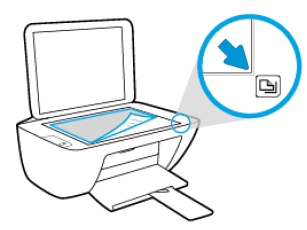This document is for HP DeskJet 3630, 3631, 3632, 3633, 3634, 3635, 3636, 3637, 3638, 3639, DeskJet Ink Advantage 3635, 3636, 3638, and DeskJet Ink Advantage Ultra 4729 All-in-One printers.
HP DeskJet 3630, 4720 Printers - Fixing Poor Print Quality
The quality of a printed document or photo is not as expected. The procedures in this document should help with streaked or faded printouts, color or black ink not printing, documents with blurred or fuzzy text, ink streaks or smears, and other print quality problems.
note:Windows operating systems only: If you are experiencing garbled, jumbled or illogical text, incomplete printouts, or missing text or graphics, go to Continuous Pages of Strange or Garbled Characters Print in Windows.Figure : Example of garbled, jumbled or illogical text, or an incomplete print job
Step 1: Use genuine HP ink cartridges
HP recommends that you use genuine HP ink or toner supplies. HP cannot guarantee the quality or reliability of non-HP or refilled cartridges. If you do not use genuine HP cartridges, the steps in this document might not resolve the issue. To check the authenticity of your cartridges, go to the HP anti-counterfeit webpage (in English).
Purchase replacement cartridges and other supplies from the HP Store or local retailers.
note:Rough handling at the store or during installation can cause print quality problems with newly installed ink cartridges. If you see print problems with newly installed ink cartridges, wait for a few hours for the automatic servicing routine to complete, and then try to print again.
Step 2: Check for ink smears on the back of printouts
If there are smears of ink on the back of your printouts, you can use an automated tool to resolve the issue.
-
Press the Power button to turn on the printer, if it is not already on.
-
Load paper into the input tray.
-
Press and hold the Power button, press the Cancel button (
 ) three times, press the Start Copy Color button (
) three times, press the Start Copy Color button ( ) eight times, and then release the Power button.
The printer feeds one page slowly. The printer might make some noise for approximately one minute.
) eight times, and then release the Power button.
The printer feeds one page slowly. The printer might make some noise for approximately one minute. -
Wait until the page is out of the printer before you remove it.
-
Examine the test page.If the print quality is unacceptable, continue to the next step.
Step 3: Make sure you are using the appropriate paper for your print job
Using incorrect paper for the print job might cause warping, lines, or streaks. Refer to the following guidelines to make sure the paper you are using is appropriate. If it is not, reload the printer with an appropriate paper type.
-
Load the paper print side up in the input tray. Many papers have printing and nonprinting sides, like photo paper and other special media. Usually, the smoother side is the "print side," and sometimes the non-print side has a logo of the paper manufacturer on it.
-
Do not use wrinkled or curled paper. Load only clean, wrinkle-free paper into the printer.

-
Use the correct paper type for your project.
-
For everyday text documents, plain paper with ColorLok technology works well. Paper with ColorLok technology is industry-standard paper that works well with HP ink.

-
For documents with dense printing, such as high contrast graphics or photographs, use HP Advanced Photo Paper for the best results.
-
Some media may not absorb ink as well as others. If your prints smear easily, make sure you are using a recommended paper.
-
-
Store photo paper in its original packaging inside a resealable plastic bag. Store the paper on a flat surface in a cool, dry place. Load 10-15 sheets of photo paper only when you are ready to print, and then put the unused paper back in the packaging.
-
Try using a different paper. This determines if the problem is related to the paper.
Try to print again. If the print quality is unacceptable, continue to the next step.
Step 4: Check the print settings
Check the print settings to make sure that they are appropriate for your print job.
note:Print settings vary by operating system and software program.
After checking the print settings, try to print again. If the print quality is unacceptable, continue to the next step.
Step 5: Check the estimated ink levels
Low ink levels can impact print quality. Select your operating system for the steps to check estimated ink levels using the HP software.
note:Ink level warnings and indicators provide estimates for planning purposes only. When an indicator shows low ink levels, consider having a replacement ink cartridge available to avoid possible printing delays. You do not need to replace ink cartridges until print quality becomes unacceptable.
-
If none of the ink cartridges are low on ink, you do not need to replace them yet. Skip to the step to print a Print Quality Diagnostic page.
-
If any of the ink cartridges are low on ink, continue to the next step.
Step 6: Replace any low or empty ink cartridges
Replace any low or empty ink cartridges, and then try to print again.
-
Press the Power button to turn on the printer, if it is not already on.
-
Load plain white paper into the input tray.
-
Open the exterior door.Figure : Open the exterior door
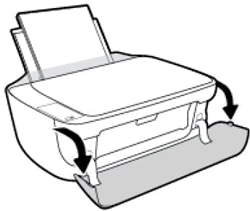
-
Open the ink cartridge access door.The carriage moves to the center of the printer.Wait until the carriage is idle and silent before you continue.Figure : Open the ink cartridge access door
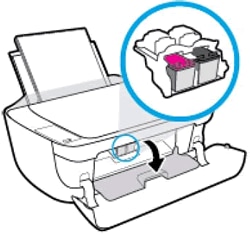
-
Lightly press down on the ink cartridge to release it, and then pull the ink cartridge out of its slot.Figure : Remove the ink cartridge
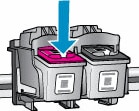
-
Remove the new ink cartridge from its packaging, and then remove the plastic tape.
caution:
Do not try to remove the copper electrical strip.Do not touch the copper-colored contacts or the ink nozzles.Do not replace the protective tape on the contacts. Handling these parts can result in clogs, ink failure, and bad electricalconnections.Figure : Remove the plastic tape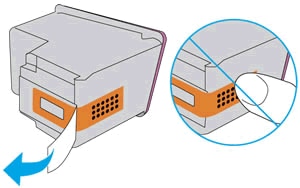
-
Hold the ink cartridge by its sides with the nozzles toward the printer, and then insert the ink cartridge into its slot. Make sure that the ink cartridge is inserted in the correct slot.
-
The tri-color ink cartridge (
 ) goes in the slot on the left.
) goes in the slot on the left.
-
The black ink cartridge (
 ) goes in the slot on the right.
) goes in the slot on the right.
-
-
Push the ink cartridge forward into its slot until it snaps into place.Figure : Snap the ink cartridge into place
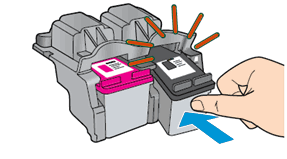
-
Repeat these steps to replace the other ink cartridge, if necessary.
-
Close the ink cartridge access door.Figure : Close the ink cartridge access door
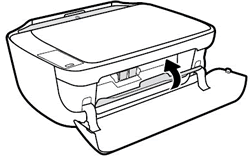
-
Close the exterior door.Figure : Close the exterior door

-
Follow any prompts on the computer screen.
-
Wait about 30 seconds for the alignment page to automatically print.
note:
The printer prints an alignment page automatically only when a new ink cartridge has been installed.
Continue to the next step to align the ink cartridges.
Step 7: Align the ink cartridges
Align the ink cartridges for the best print quality.
-
Lift the scanner lid.
-
Place the alignment page with the print side down on the right-front corner of the scanner glass. See the engraved guide next to the scanner glass for help loading the alignment page.
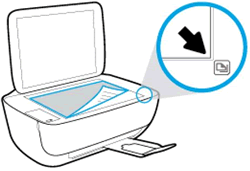
-
Close the scanner lid.
-
Press the Start Copy Black button
 or the Start Copy Color button
or the Start Copy Color button  on the printer control panel.
The printer aligns the ink cartridges.
on the printer control panel.
The printer aligns the ink cartridges.note:
If the alignment page fails to automatically print, you can manually print an alignment page using the HP Printer Assistant software (Windows) or the Printer Utility (macOS or OS X).
Try to print. If the print quality is unacceptable, continue to the next step.
Step 8: Print a Print Quality Diagnostic page
Select your operating system for the steps to print a Print Quality Diagnostic page using the HP software, and then evaluate the results.
Step 9: Examine the color blocks for defects
Examine the color blocks on the Print Quality Diagnostic page to make sure that the color blocks do not show white lines, and are not faded or missing.
Figure : Example of the color blocks without defects

-
If the color blocks do not show white lines, and are not faded or missing, skip to the step to check the alignment lines.
-
If any of the color blocks show white lines, are faded, or are missing completely, continue to the next step.
Step 10: Clean the ink cartridges
Select your operating system for the steps to clean the ink cartridges using the HP software, and then evaluate the results.
note:To avoid issues that require cleaning, always turn the printer off with the Power button.
If the print quality is unacceptable, continue to the next step.
Step 11: Examine the alignment lines and green color block for defects
Examine the alignment lines and green color block on the Print Quality Diagnostic page. Make sure that the lines are straight and connected and that there are no dark lines or white gaps in the green color block.
Figure : Example of the alignment lines without any defects

Figure : Example of the green color block without any defects
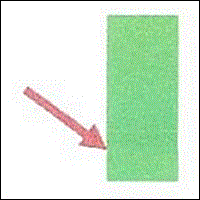
-
If you see no defects on the Print Quality Diagnostic page, the print mechanism and ink cartridges are working correctly. If print quality is still not satisfactory, try these general print-quality guidelines. You do not need to continue the troubleshooting steps in this document.
-
Make sure that the image you are printing has a high enough resolution. Images that have been enlarged might appear fuzzy or blurry.
-
If the problem is near the edge of a printout, use the print settings to rotate the image 180 degrees. The problem might not appear on the other end of the printout.
-
Do not leave unprotected ink cartridges out of the printer for an extended period of time.
-
Always use the power button to turn the printer off. This protects the ink cartridges from exposure to air.
-
-
If any of the alignment lines are not straight and connected, or the green color block has dark lines or white gaps, continue to the next step.
Step 12: Align the printer
Aligning the ink cartridges correctly aligns the printhead with the printer. Select your operating system for the steps to align the ink cartridges using the HP software, and then evaluate the results.
Step 13: Manually clean the area around the ink nozzles
Do not perform these steps unless the test page or printout specifically shows smeared text or track marks. Clean the area around the ink nozzles if you see track marks or smears on the printouts.
Figure : Example of smeared text

Figure : Example of text with track marks

-
Gather the following materials:
-
Dry foam-rubber swabs, lint-free cloth, or any soft material that does not come apart or leave fibers (coffee filters work well)
-
Distilled, filtered, or bottled water (tap water might contain contaminants that can damage the ink cartridges)
caution:
Do not use platen cleaners or alcohol to clean the ink cartridge contacts. These can damage the ink cartridge or the printer.
-
-
Press the Power button to turn on the printer, if it is not already on.
-
Open the exterior door, and then grasp the handle and lower the ink cartridge access door to open it.The carriage moves to the center of the printer.Figure : Open the ink cartridge access door

-
Wait until the carriage is idle and silent before you continue.
-
Lightly press down on one of the ink cartridges to release it, and then pull the ink cartridge toward you out of its slot.Figure : Press down to remove the ink cartridge

caution:
Do not remove both ink cartridges at the same time. Remove and clean each ink cartridge one at a time. Do not leave an ink cartridge outside the printer for more than 30 minutes. -
Hold the ink cartridge by its sides.Figure : Hold the ink cartridge by its sides
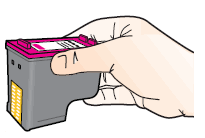
-
Inspect the ink cartridge contacts for ink and debris buildup.
caution:
Do not touch the copper-colored contacts or the ink nozzles. Touching these parts can result in clogs, ink failure, and bad electrical connections.Figure : Do not touch the contacts or nozzles
-
Lightly moisten a foam-rubber swab or lint-free cloth with distilled water, and then squeeze any excess water from it.
-
Clean the face and edges around the ink nozzle with the swab.
caution:
Do not clean the ink nozzle plate.-
Nozzle plate - Do not clean
-
Area surrounding ink nozzle - Do clean
-
Ink cartridge contacts - Do not clean
Figure : Clean the area around the ink nozzle
-
-
Either let the ink cartridge sit for 10 minutes to allow the cleaned area to dry, or use a new swab to dry it.
-
Slide each ink cartridge at a slight upward angle into the empty slot, and then gently push up on each ink cartridge until it locks into place.Figure : Push the ink cartridge into its slot
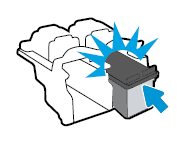
-
Repeat these steps to clean around the nozzles on the other ink cartridge.
-
Close the ink cartridge access door.
-
Reconnect the power cord to the rear of the printer.
-
Press the Power button to turn on the printer, if it does not turn on automatically.
Step 14: Replace the problem ink cartridge
Replace the problem ink cartridge if you saw defects on the Print Quality Diagnostic page and the preceding steps did not resolve the issue, even if the ink cartridge is not low on ink. The problem ink cartridge is the one that printed the defects on the Print Quality Diagnostic page as described earlier in this document.
If you have a defective cartridge or printhead, it might be under warranty. To check the warranty on your ink or toner supplies, go to Printer and Page Yield Overview, and then review the limited warranty information for your supplies.
-
Press the Power button to turn on the printer, if it is not already on.
-
Load plain white paper into the input tray.
-
Open the exterior door.Figure : Open the exterior door

-
Open the ink cartridge access door.The carriage moves to the center of the printer.Wait until the carriage is idle and silent before you continue.Figure : Open the ink cartridge access door

-
Lightly press down on the ink cartridge to release it, and then pull the ink cartridge out of its slot.Figure : Remove the ink cartridge

-
Remove the new ink cartridge from its packaging, and then remove the plastic tape.
caution:
Do not try to remove the copper electrical strip.Do not touch the copper-colored contacts or the ink nozzles.Do not replace the protective tape on the contacts. Handling these parts can result in clogs, ink failure, and bad electricalconnections.Figure : Remove the plastic tape
-
Hold the ink cartridge by its sides with the nozzles toward the printer, and then insert the ink cartridge into its slot. Make sure that the ink cartridge is inserted in the correct slot.
-
The tri-color ink cartridge (
 ) goes in the slot on the left.
) goes in the slot on the left.
-
The black ink cartridge (
 ) goes in the slot on the right.
) goes in the slot on the right.
-
-
Push the ink cartridge forward into its slot until it snaps into place.Figure : Snap the ink cartridge into place

-
Repeat these steps to replace the other ink cartridge, if necessary.
-
Close the ink cartridge access door.Figure : Close the ink cartridge access door

-
Close the exterior door.Figure : Close the exterior door

-
Follow any prompts on the computer screen.
-
Wait about 30 seconds for the alignment page to automatically print.
note:
The printer prints an alignment page automatically only when a new ink cartridge has been installed.
Continue to the next step to align the ink cartridges.
Step 15: Align the ink cartridges
Align the ink cartridges for the best print quality.
-
Lift the scanner lid.
-
Place the alignment page with the print side down on the right-front corner of the scanner glass. See the engraved guide next to the scanner glass for help loading the alignment page.

-
Close the scanner lid.
-
Press the Start Copy Black button
 or the Start Copy Color button
or the Start Copy Color button  on the printer control panel.
The printer aligns the ink cartridges.
on the printer control panel.
The printer aligns the ink cartridges.note:
If the alignment page fails to automatically print, you can manually print an alignment page using the HP Printer Assistant software (Windows) or the Printer Utility (macOS or OS X).
Print another Print Quality Diagnostic page. If the print quality is unacceptable, continue to the next step.
Step 16: Service the printer
If you have followed all the steps in this document and your printer is producing printouts with print quality issues, service the printer.
Service or replace your HP product if the issue persists after completing all the preceding steps.
Go to Contact HP Customer Support to schedule a product repair or replacement. If you are in Asia Pacific, you will be directed to a local service center in your area.
To confirm your warranty status, go to HP Product Warranty Check. Repair fees might apply for out-of-warranty products.
note:Keep a print sample that shows the problem. If the ink cartridges, printhead, or printer is replaced under warranty, the support agent will request the print sample. If the printer is returned to HP, the print sample must be returned with the printer. Place the sample in the output tray when you package your printer for shipping.
Enter a topic to search our knowledge library
What can we help you with?
Need Help?
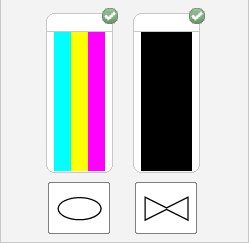
 ).
).
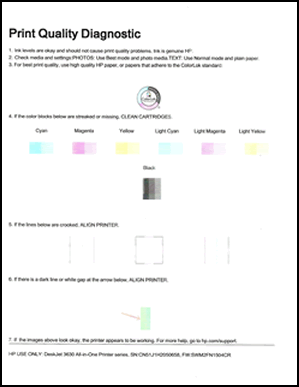
 ).
).
 ).
).
